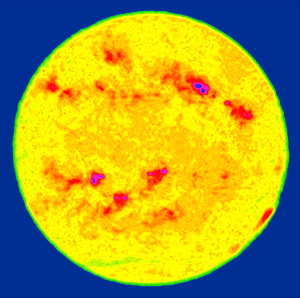The Sun
One of ALMA’s special features is that, besides being able to observe the distant Universe, day and night, it is also able to observe the Sun directly. The antennae were designed specifically so that the Sun’s strong radiation would not affect its instruments.
When observing within millimeter and submillimeter wavelengths, which ALMA can capture (0.4 mm to 3 mm), the image of the Sun tends to become blurred. This is compensated by a longer separation of the antennae – up to 16Kms – which provides better resolution, or ability to see details. Thus, astronomers can have access to unprecedented observations of our nearest star, in order to study its physical processes, such as its huge flares and its electromagnetic field.
ALMA can observe a wide variety of phenomena on the Sun:

- The structure of the quiet solar atmosphere.
- Coronal holes (where vast solar winds originate because of diverging magnetic fields).
- Solar active regions.
- Active and quiescent filaments.
- Energetic phenomena, like filament eruptions and flares.
All the above will lead to significant progress in the future, in the following scientific areas:
Flares: Solar flares involve the catastrophic release of energy in the low-solar corona which heats plasma and accelerates ions and electrons to relativistic energies on short timescales. ALMA probes emissions from the most energetic electrons, shedding light on the questions of when, where, and by what mechanism are electrons promptly accelerated to high energies.
Filaments: Solar prominences and filaments are, as their name suggests, large filamentary structures composed of relatively cold (~6200 ºC), dense plasma suspended in the hot, 3 million degree solar corona. They occur along magnetic neutral lines in both active and quiet regions of the Sun. Some simply fade away after a lifetime of days to weeks; others are expelled from the Sun in spectacular eruptions. Their birth and death is still mysterious in many ways. ALMA will span those wavelengths at which filaments become optically thin. Their structure and evolution will be more accessible to ALMA than any other instrument.
Structure of the low solar atmosphere: One of the great mysteries of the Sun is why it has a solar corona. At the height of the photosphere (the visible surface of the Sun), the temperature is ~5880 ºC. The temperature then decreases with height for several hundred kilometers. But then something amazing occurs: at greater heights, the temperature increases, gradually at first, and then suddenly to ~3 million degrees! ALMA studies the "minimum temperature" region where the phenomenon is manifested. By imaging this region of the solar atmosphere at various millimeter and submillimeter wavelengths, ALMA will offer a means of characterizing the structure and evolution of the low solar atmosphere and how that structure is maintained. ALMA will also be able to exploit helioseismology to explore the details of the structure of the low solar atmosphere since the hydro-mechanical waves cause brightness variations in the millimeter and submillimeter emission.
New spectral line diagnostics: At wavelengths longward of ~1mm, no spectral lines are available for diagnostic purposes. Pressure and Zeeman broadening (due to the presence of magnetic fields) is so extreme as to render them undetectable. At submillimeter wavelengths, however, it should be possible to detect high-n radio recombination lines of hydrogen and certain ions. These offer the possibility of constraining the temperature, density, magnetic field strength, and mass motions in the low solar atmosphere, layers of the atmosphere that are inaccessible by other means.
Why is ALMA better than others at doing this?: ALMA is designed to operate at millimeter and submillimeter wavelengths, from roughly 350 microns to 9.6 mm. In contrast, the Very Large Array (VLA) operates at much longer wavelengths, from 1.3 cm to 4 meters; and the Hubble Space Telescope (HST) and ground-based optical telescopes like the Very Large Telescope (VLT) or the Subaru operate at much shorter wavelengths (about half a micron). ALMA therefore fills in the gap between optical/infrared telescopes, and radio telescopes. The reason this is scientifically interesting is the radiation at millimeter and submillimeter wavelengths is caused by different physical mechanisms than that produced at longer and shorter wavelengths. And it originates in different regions of the solar atmosphere. Millimeter and submillimeter observations therefore give us a new probe of physical processes on the Sun.
ALMA explores the worlds around our Sun
The Solar System is a small part of the Universe that we can visit by means of robotic probes. But money is available just for a few probes at a time, and there are thousands of planets, moons, asteroids and comets to explore. Therefore, a great task lies ahead for ground-based observatories.
ALMA observes planets and can measure their wind. It can analyze molecules emitted by comets and asteroids, even when these reach their most active point, while passing near the Sun, where they cannot be observed through other telescopes.
Studying the building-blocks of comets will provide new insight regarding the early formation of the Solar System, likewise as the observation of molecules spread through space.
ALMA will discover new objects within the Kuiper Belt (which we now know belongs to Pluto), by observing their own emitted light, (not the light reflected by the Sun), as they were studied up to now, allowing us to calculate their actual size.
